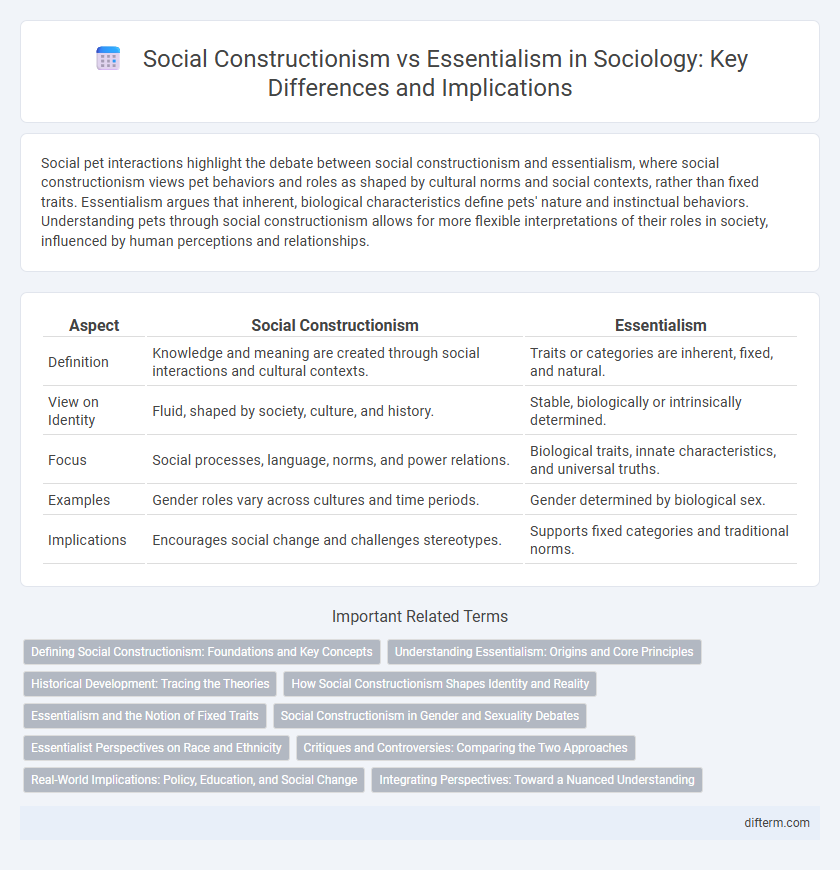Social pet interactions highlight the debate between social constructionism and essentialism, where social constructionism views pet behaviors and roles as shaped by cultural norms and social contexts, rather than fixed traits. Essentialism argues that inherent, biological characteristics define pets' nature and instinctual behaviors. Understanding pets through social constructionism allows for more flexible interpretations of their roles in society, influenced by human perceptions and relationships.
Table of Comparison
| Aspect | Social Constructionism | Essentialism |
|---|---|---|
| Definition | Knowledge and meaning are created through social interactions and cultural contexts. | Traits or categories are inherent, fixed, and natural. |
| View on Identity | Fluid, shaped by society, culture, and history. | Stable, biologically or intrinsically determined. |
| Focus | Social processes, language, norms, and power relations. | Biological traits, innate characteristics, and universal truths. |
| Examples | Gender roles vary across cultures and time periods. | Gender determined by biological sex. |
| Implications | Encourages social change and challenges stereotypes. | Supports fixed categories and traditional norms. |
Defining Social Constructionism: Foundations and Key Concepts
Social constructionism asserts that knowledge, identity, and reality are created through collective social processes rather than existing inherently. It emphasizes the role of language, culture, and power dynamics in shaping perceptions and social norms. Core concepts include the idea that meanings are negotiated, contexts influence understanding, and social categories are fluid rather than fixed.
Understanding Essentialism: Origins and Core Principles
Essentialism posits that certain traits or behaviors are innate, biologically determined, and universally shared among members of a group, emphasizing fixed characteristics over social influences. Rooted in classical philosophy and biological determinism, essentialism views categories such as gender, race, and identity as natural and immutable. This framework contrasts sharply with social constructionism by denying the fluidity and cultural variability of these social categories, asserting stable, inherent essences behind social phenomena.
Historical Development: Tracing the Theories
Social constructionism traces its origins to the mid-20th century, emphasizing how social realities are created through language, culture, and collective agreement, with key contributions from Berger and Luckmann's "The Social Construction of Reality" (1966). Essentialism, with roots in classical philosophy, asserts that social categories have inherent, unchanging essences, a perspective evident in early biological determinism and ancient metaphysical ideas. The historical development of these theories reflects a shift from fixed, essentialist views of identity to more fluid, constructed understandings shaped by social context and interaction.
How Social Constructionism Shapes Identity and Reality
Social constructionism asserts that identity and reality are shaped through social interactions, language, and shared meanings rather than inherent, fixed traits. It emphasizes that concepts such as gender, race, and class are fluid and contingent upon cultural and historical contexts. This perspective reveals how societal norms and power structures influence individual and collective self-perceptions, challenging essentialist views that attribute identity to innate characteristics.
Essentialism and the Notion of Fixed Traits
Essentialism asserts that individuals possess inherent, unchangeable traits that define their identity and behavior across various social categories such as gender, race, and ethnicity. This perspective views these fixed traits as biologically or naturally determined, resisting cultural or social influence. Critiques highlight that essentialism overlooks the fluidity and context-dependence of identity, contrasting sharply with social constructionist views that emphasize the role of social processes in shaping human characteristics.
Social Constructionism in Gender and Sexuality Debates
Social constructionism in gender and sexuality debates emphasizes that identities and roles are shaped by cultural, historical, and social contexts rather than fixed biological traits. This perspective argues that gender and sexual categories are fluid and created through social interactions, language, and power relations. Studies in sociology and psychology highlight how norms and expectations evolve, challenging essentialist views that define identities as innate or universally consistent.
Essentialist Perspectives on Race and Ethnicity
Essentialist perspectives on race and ethnicity assert that these identities are rooted in inherent, biological, or genetic differences that define distinct groups. This viewpoint emphasizes fixed traits and qualities as the basis for social categories, often overlooking cultural, historical, and social influences. Essentialism in race and ethnicity can perpetuate stereotypes and justify social inequalities by portraying group characteristics as natural and unchangeable.
Critiques and Controversies: Comparing the Two Approaches
Social constructionism faces critiques for potentially downplaying biological influences and promoting relativism, which challenges objective truth claims; essentialism is criticized for reinforcing fixed identities and ignoring social context. Debates between these approaches center on whether traits are innate or shaped by social processes, influencing disciplines like gender studies and psychology. Both frameworks generate controversies regarding identity politics, with constructionism favoring fluidity and essentialism emphasizing inherent characteristics.
Real-World Implications: Policy, Education, and Social Change
Social constructionism impacts policy by promoting inclusive frameworks that recognize identity fluidity and challenge rigid classifications, influencing laws on gender and race. Essentialism, by contrast, often informs policies based on fixed traits, potentially limiting diversity and reinforcing stereotypes in educational curricula. Embracing social constructionist principles facilitates social change by encouraging adaptive, equity-focused reforms that address systemic inequalities more effectively.
Integrating Perspectives: Toward a Nuanced Understanding
Social constructionism and essentialism offer contrasting views on identity formation, with the former emphasizing social and cultural influences while the latter highlights inherent traits. Integrating these perspectives fosters a nuanced understanding by acknowledging that identities emerge through dynamic interactions between biological factors and social contexts. This approach enables more comprehensive analyses in fields like gender studies, race relations, and cognitive development by balancing the fluidity of social constructs with the stability of essential characteristics.
social constructionism vs essentialism Infographic

 difterm.com
difterm.com